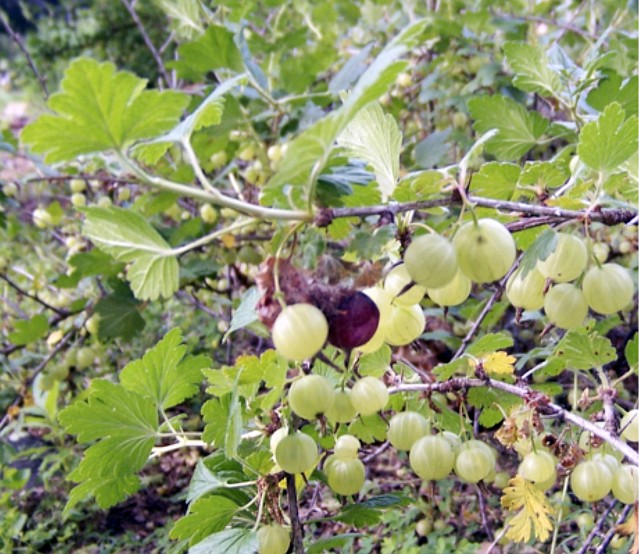Q: I get these green worms inside my gooseberries every year. How do I control them? I picked them all this year early because they got into so many the last year or two.
A: My goodness, you learn something new every day! I have generally referred to gooseberries (see picture) as having little insect pest concerns. This dastardly devil is the aptly named "gooseberry fruitworm" and is larval stage of a moth, Zophodia convolutella (Hbier). It is a greenish worm with darker stripes along the sides. The worms feed by hollowing out the insides of the fruit of currants and gooseberries; each worm consumes several berries. Two natural based products can be used to control them, Bacillus thuringiensis-based products (e.g. Thuricide or Dipel) or spinosad (e.g. Captain Jack's Deadbug Brew). Make two applications 10 days apart, starting at early fruit development.
They are starting into my gooseberry patch. I noticed a little damage last year, but his year is much more. Thanks for the heads up!
Q: I am concerned about those community garden plots across the bridge. What will people have to do to restore them to plant again? Are they getting contaminated?
A: This is addressed in a publication posted for commercial growers. Three specific Q&As address your concern. They are presented in the order one would take to restore the plot.
What precautions should I take during clean-up?
Workers should wear protective clothing such as rubber boots, rubber gloves and an N-95 respirator mask when working in fields that were flooded. (any dust/dirt has some microbial risk)
My field has large depositions of silt and debris. Do I need to remove this, test it, or can I till it in?
Large debris in your fields should be removed, but the silt deposited by floodwater and smaller debris do not need to be removed. Soils should be allowed to dry sufficiently and then tilled to at least 6 inches deep before planting crops. Adding compost or other organic matter when tilling will be beneficial to the soil's biological activity, which can promote decomposition of some contaminants. To protect the soil from erosion after tilling, it is advisable to plant a cover crop, which will also stimulate biological activity. In the fall, consider planting small grains such as oats or winter rye with or without hairy vetch for adding nitrogen.
What kind of soil tests should I do before I plant again?
Biological contaminants (those that are carbonbased) will break down over time in the soil, and it is difficult to conduct meaningful tests for these due to their variety and spatial distribution. Heavy metals, however, will not break down over time, and can be tested for more easily using traditional soil sampling methods. You can contact the MU Soil and Plant Testing lab in Columbia at 573-882-0623 for more information on their testing services. (From: ipm.missouri.edu/MEG/2017/5/FAQfloodedProduce/)
In general, if you can till up the soil later this year and plant a cover crop for the winter, that is ideal. Adding compost across the soil just before planting can reinvigorate natural microorganisms. The produce grown there next year should be safe. Any contamination from petroleum based products (oils and pesticides) would be extremely dilute and will break down quickly. If concerned about heavy metals, test for lead and arsenic.
Q: When will the Japanese beetles start up again? Will all this rain knock them back?
A: Well, the drought of 2012 knocked them back the following year, but the very rainy years of 2008-09 saw them do just fine. They would be suffocated under floodwater after enough time.
Some degree day models are showing they'll start emerging in this area beginning this weekend. More heavy rain could hold them back a week or so. As of June 3, we had none in our trap. They start slow and really ramp up about two weeks into their "season." July 4 has often been the peak or its start. Highly attractive plants should be preventatively treated ASAP. The most widely labeled products and easily found at local retailers are Spectracide Triazide Insect Killer and Sevin (spray). The former is about a third of the price of Sevin, for the amount of spray solution that it makes. As always, read the label and follow its instructions. Spray insecticides in the evening to reduce the negative effects on bees.

